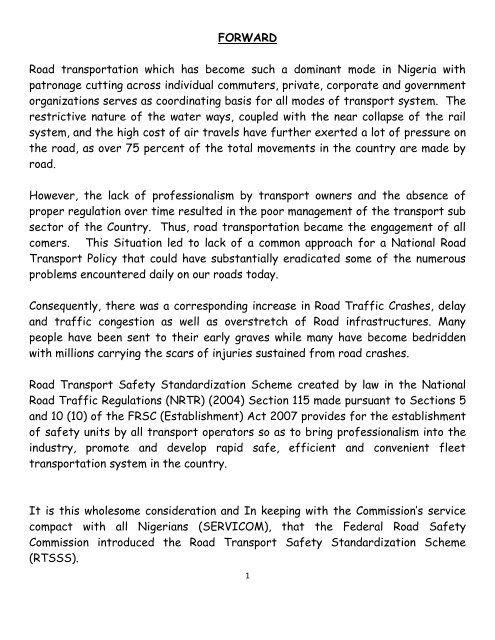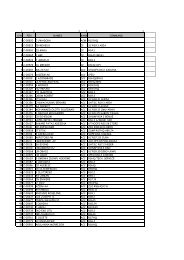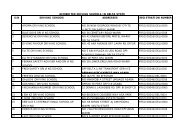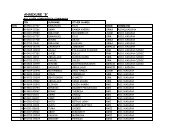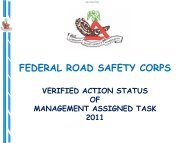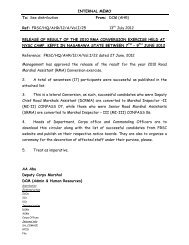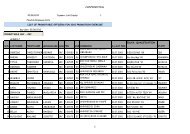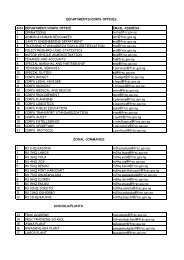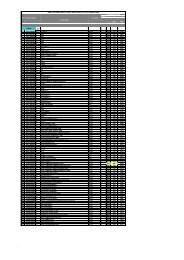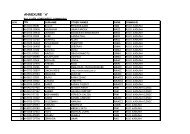Road Transport Safety Standardization Scheme - FRSC Official ...
Road Transport Safety Standardization Scheme - FRSC Official ...
Road Transport Safety Standardization Scheme - FRSC Official ...
Create successful ePaper yourself
Turn your PDF publications into a flip-book with our unique Google optimized e-Paper software.
FORWARD<br />
<strong>Road</strong> transportation which has become such a dominant mode in Nigeria with<br />
patronage cutting across individual commuters, private, corporate and government<br />
organizations serves as coordinating basis for all modes of transport system. The<br />
restrictive nature of the water ways, coupled with the near collapse of the rail<br />
system, and the high cost of air travels have further exerted a lot of pressure on<br />
the road, as over 75 percent of the total movements in the country are made by<br />
road.<br />
However, the lack of professionalism by transport owners and the absence of<br />
proper regulation over time resulted in the poor management of the transport sub<br />
sector of the Country. Thus, road transportation became the engagement of all<br />
comers. This Situation led to lack of a common approach for a National <strong>Road</strong><br />
<strong>Transport</strong> Policy that could have substantially eradicated some of the numerous<br />
problems encountered daily on our roads today.<br />
Consequently, there was a corresponding increase in <strong>Road</strong> Traffic Crashes, delay<br />
and traffic congestion as well as overstretch of <strong>Road</strong> infrastructures. Many<br />
people have been sent to their early graves while many have become bedridden<br />
with millions carrying the scars of injuries sustained from road crashes.<br />
<strong>Road</strong> <strong>Transport</strong> <strong>Safety</strong> <strong>Standardization</strong> <strong>Scheme</strong> created by law in the National<br />
<strong>Road</strong> Traffic Regulations (NRTR) (2004) Section 115 made pursuant to Sections 5<br />
and 10 (10) of the <strong>FRSC</strong> (Establishment) Act 2007 provides for the establishment<br />
of safety units by all transport operators so as to bring professionalism into the<br />
industry, promote and develop rapid safe, efficient and convenient fleet<br />
transportation system in the country.<br />
It is this wholesome consideration and In keeping with the Commission‟s service<br />
compact with all Nigerians (SERVICOM), that the Federal <strong>Road</strong> <strong>Safety</strong><br />
Commission introduced the <strong>Road</strong> <strong>Transport</strong> <strong>Safety</strong> <strong>Standardization</strong> <strong>Scheme</strong><br />
(RTSSS).<br />
1
The scheme is therefore compulsory for all fleet operators (Private, Corporate<br />
and Government transport companies) with five (5) or more vehicles to be<br />
properly registered and regulated to improve the safety of the operations.<br />
This booklet, a review of the earlier publication, is written in a practical language<br />
for easy understanding as a Policy Document on fleet transport legislations and<br />
technical standards which professionals throughout the transport industry will<br />
rely on for an efficient and effective operation. It does not only give room for<br />
best service delivery but also enhances safety, fleet maintenance, longevity,<br />
sustainability of fleet operations and fuller lives for all Nigerians. All are<br />
therefore enjoined to take advantage of the scheme which is aimed at improving<br />
the nation‟s road transport sub sector of the economy.<br />
LET US ENSURE SAFER ROADS, FULLER LIVES.<br />
OSITA CHIDOKA<br />
CORPS MARSHAL/CHIEF EXECUTIVE<br />
<strong>FRSC</strong>, NIGERIA<br />
JUN, 09.<br />
2
A. INTRODUCTION<br />
1. The <strong>Road</strong> <strong>Transport</strong> system accounts for over 75% of mobility needs in<br />
Nigeria. This exerts excessive pressure on the road transport industry.<br />
Available statistics from the Department of Motor Vehicle Administration<br />
(MVA) of the Federal <strong>Road</strong> <strong>Safety</strong> Commission (<strong>FRSC</strong>) shows that the<br />
Commission has as at December 2008 a total of 13,277,933 vehicles and<br />
motorcycles issued the Vehicle Identification Number plates in its data<br />
bank. Available records indicate that Nigeria has about 14 (Fourteen) million<br />
registered vehicles.<br />
2. The Federal Ministry of <strong>Transport</strong> also informed that the total road<br />
network is about 200,000 km out of which Federal roads account for about<br />
34,000 km which are mostly inter-state roads with high traffic density and<br />
attendant <strong>Road</strong> Traffic Crashes.<br />
3. Within the last decade, a new challenge in Public transportation in Nigeria<br />
emerged with a phenomenal growth in night travels with attendant negative<br />
consequences. <strong>FRSC</strong> statistics indicated that though the rate of <strong>Road</strong><br />
Traffic Crashes (RTC) at night is not as high as the number during the<br />
daytime, the fatality is higher. The fatality from a single road crash at night<br />
has been known to outstrip ten occurrences at day time, because of poor<br />
road conditions, unlighted streets/roads, disregard to traffic rules and<br />
regulations and poor rescue services.<br />
4. It has been revealed that the haulage operators as well as luxury passenger<br />
bus operators programme their movements to night because of multiple<br />
taxations by government agencies and also due to the preference of night<br />
travels by some commuters, especially businessmen who see night trips as<br />
savings in time and costs, particularly in avoiding paying for accommodation.<br />
5. The <strong>FRSC</strong> has also observed that Fleet Operation in the country is not<br />
properly regulated and many operators lack the basic competence in terms<br />
of handling road safety issues. <strong>Safety</strong> is relegated to the background.<br />
Hence, Section 115 of the National <strong>Road</strong> Traffic Regulations (2004), made<br />
3
pursuant to Sections 5 and 10 (10) of the <strong>FRSC</strong> (Establishment) Act 2007<br />
provides for the establishment of <strong>Safety</strong> Units and appointment of<br />
competent <strong>Safety</strong> Managers by all road transport operators.<br />
6. Arising from the above provisions, the <strong>Scheme</strong> referred to as the <strong>Road</strong><br />
<strong>Transport</strong> <strong>Safety</strong> <strong>Standardization</strong> <strong>Scheme</strong> (RTSSS) is hereby formulated<br />
and adopted as <strong>Road</strong> Traffic <strong>Safety</strong> working document. The <strong>Scheme</strong> is being<br />
implemented through the Corps <strong>Transport</strong> <strong>Standardization</strong> Office (CTSO)<br />
at the Federal <strong>Road</strong> <strong>Safety</strong> Commission National Headquarters (RSHQ).<br />
There are <strong>Transport</strong> <strong>Standardization</strong> Officers in all the field commands of<br />
the <strong>FRSC</strong> to implement the scheme nationwide. RTSSS is a road transport<br />
regulatory policy which stipulates minimum safety requirements for fleet<br />
operators (organizations, Ministries, Departments and Agencies as well as<br />
companies and other road transport owners) with a minimum of five (5)<br />
vehicles in their fleet.<br />
7. The concept and the implementation of the <strong>Scheme</strong> address certain issues<br />
that are discussed below:<br />
a. Data Base.<br />
8. The absence of a Database and adequate information on <strong>Road</strong> <strong>Transport</strong><br />
Operators (RTOs) has led to ineffective planning for efficient road<br />
transport system in Nigeria. Therefore, the Federal <strong>Road</strong> <strong>Safety</strong><br />
Commission is determined to have amongst others, a database for all<br />
registered <strong>Transport</strong> Companies and other fleet operators with at least 5<br />
(five) vehicles in their fleet, to have the required information for effective<br />
planning, monitoring, advice and sanctions as may be necessary. The essence<br />
is to regulate their activities.<br />
9. The scheme is to entrench a culture of safety consciousness in organizations<br />
and companies with fleet of vehicles, ensure safe and standardized fleet<br />
operations for all and check the excesses of transport operators which<br />
often lead to loss of lives and property.<br />
The data is to be collated by the <strong>FRSC</strong> Field Commands in each State of the<br />
Federation and coordinated by the Corps <strong>Transport</strong> <strong>Standardization</strong> Office<br />
(CTSO) at the RSHQ. The various stakeholders, like the Nigeria Association<br />
of <strong>Road</strong> <strong>Transport</strong> Owners (NARTO), Association of Luxury Bus Owners of<br />
4
Nigeria (ALBON), National Union of <strong>Road</strong> <strong>Transport</strong> Workers (NURTW),<br />
<strong>Road</strong> <strong>Transport</strong> Employers Association of Nigeria (RTEAN), etc are to note<br />
that the essence of gathering the information is not for taxation but for<br />
regulation, certification, monitoring and better operations of all registered<br />
transport companies. In line with section 115(2) of the NRTR, 2004 “The<br />
Commission shall maintain a databank of all transport operators having up to<br />
five (5) vehicles in their fleet and shall issue appropriate forms for data<br />
collection, certification and registration of operators, safety officers and all<br />
necessary operational activities as may be required from time to time”.<br />
Section 115 (3) provides sanction of N50,000.00 (Fifty thousand naira ) for<br />
non-compliance. These efforts are geared towards safe road culture.<br />
b. Classification.<br />
a. The <strong>Road</strong> <strong>Transport</strong> <strong>Safety</strong> <strong>Standardization</strong> <strong>Scheme</strong> (RTSSS) is<br />
classified into 7 (seven) broad areas as follows:<br />
i Compilation and Registration of fleet operators.<br />
ii Certification of transport operators.<br />
iii Improving quality of driver‟s training.<br />
iv Collaborative efforts among law makers, law enforcement agencies and<br />
transport operators.<br />
v Continuous inspection of Fleet Operators / activities.<br />
vi Enforcement of Model <strong>Safety</strong> Policy for Fleet Operators and<br />
vii Evaluation and Reporting.<br />
B. CERTIFICATION OF TRANSPORT OPERATORS IN COMPLIANCE<br />
WITH SAFETY STANDARDS.<br />
10. For any <strong>Transport</strong> Company to be certified, it must comply with the<br />
following <strong>Safety</strong> Standards, sub-divided into 3 broad areas:<br />
i Operator‟s <strong>Safety</strong> Standard;<br />
ii Driver‟s <strong>Safety</strong> Standard;<br />
iii Vehicle <strong>Safety</strong> Standard;<br />
(See Appendix „B‟)<br />
5
i. OPERATOR‟S SAFETY STANDARD<br />
11. In order to ensure effective implementation of the <strong>Scheme</strong>, Operators<br />
should evolve a standard approach that will encompass the basic elements,<br />
namely; the art of effective administration, the roadworthiness of vehicles and<br />
the supervision of drivers.<br />
a) Though Fleet Operators provide essential services, either as commercial<br />
ventures to maximize profit, or as welfare, they are nevertheless bound to<br />
build confidence in their clients as well as operate within prescribed and<br />
regulated operational standards for harmony.<br />
b) After all, no client will subscribe to an aborted or ill-fated journey if there<br />
is a premonition of such occurrence. Similarly, no responsible government will<br />
refuse to regulate its transport sector, which in Nigeria, is being patronized<br />
by over 80% of its citizens either through human movement or freight<br />
haulage and which over the years has posted quite mind boggling negative<br />
records in wanton loss of productive lives and valuable properties due to<br />
road crashes occasioned by human errors.<br />
c) Consequently, the government, through the Federal <strong>Road</strong> <strong>Safety</strong> Commission<br />
has risen to its responsibilities and has introduced a well thought-out,<br />
compact and articulate Fleet Operators‟ <strong>Safety</strong> Policy. The Policy mandates<br />
all Fleet Operators to engage in the following:<br />
Establish fully functioning <strong>Safety</strong> Units , headed by qualified, competent and<br />
experienced <strong>Safety</strong> Managers who are expected to be adequately<br />
knowledgeable about the intricacies involved in the National <strong>Road</strong> <strong>Transport</strong><br />
Regulations and other requirements such as vehicle mechanics, route<br />
knowledge, vehicle and passenger documentation, driver‟s training and<br />
discipline as well as law enforcement/operators‟ relations. These are to<br />
6
ensure that the operations of the fleet owners run smoothly and in<br />
appreciable manner.<br />
Provide standard terminus/registered office in locations that will not lead to<br />
traffic problems like congestion. These will not only make room for safe<br />
alighting/boarding but also accessibility of location for all purposes.<br />
Put in place a standard recruitment policy, as well as driver‟s certification<br />
programme for its drivers in addition to educational attainment and to<br />
ensure that whoever is engaged by them conforms with the relevant<br />
provisions of section 23-52 of the National road Traffic Regulations, 2004,<br />
which stipulates conditions for issuance, and guidelines for continued holding<br />
of driver‟s licence. This section also provides for categories of licence, usage<br />
of vehicles as well as conduct of drivers.<br />
Employers / Operators must not use a driver who has invalid licence or<br />
whose licence is suspended, revoked or cancelled, or is disqualified from<br />
driving. Non-qualified drivers should not be engaged by the operators.<br />
Ensure established policy on training and re-training of drivers: This is to<br />
ascertain the continuous capabilities of drivers, as well as their conformity<br />
with the dynamism of their professional so as to eliminate deficiency<br />
resulting in avoidable hardship both for the operators and passengers.<br />
Ignorance of the law remains no excuse. All drivers are expected to go<br />
through yearly refresher courses to enhance their competency. Yearly<br />
returns on Drivers Training must be forwarded to <strong>FRSC</strong>.<br />
Operate comprehensive vehicle maintenance policy: This is in line with<br />
provisions of RTSSS policy; vis a vis provision for operator‟s vehicle safety<br />
standards which encompasses all components of the vehicle and must ensure<br />
proper functioning of all parts. Such parts must be in conformity with body<br />
specifications and accessories.<br />
Implement the approved Passengers‟ Manifest: This is in line with the<br />
National <strong>Road</strong> Traffic Regulation, 2004 Section 51(5) which makes it<br />
compulsory for all passengers to give the correct information about<br />
themselves for documentation, or be refused entry into the vehicle. (See a<br />
sample of the approved Passengers‟ Manifest on Page 28, Appendix “C”)<br />
7
Operators are expected to write on their vehicles contact telephone<br />
numbers preferably, those of the <strong>Safety</strong> Managers for feedback from the<br />
public especially on the conduct of their drivers.<br />
Operator must ensure that vehicles are operated in compliance with the<br />
minimum vehicle <strong>Safety</strong> Standard and in accordance with the provisions of<br />
the National <strong>Road</strong> Traffic Regulation, 2004, especially as it concerns vehicle<br />
maintenance and state of road worthiness.<br />
All Fleet Operators must enforce mandatory rest hours for drivers. No<br />
driver is expected to drive beyond nine (9) hours within a 24 hour period.<br />
All vehicles for night travels must have two (2) drivers.<br />
All fleet vehicles must be equipped with First Aid Bags.<br />
All fleet vehicles must have reflective warning signs, retro-reflective strips<br />
at sides and tailboards in addition to standard lightings.<br />
All commercial vehicles must have functional speed limiting devices.<br />
Fleet Operators should ensure the installation of Tacho-graph and speed<br />
governors to monitor speed violations.<br />
All types of vehicles must be driven in compliance with the applicable speed<br />
limits, considering nature and circumstance of roads and locations.<br />
Fleet Operators must ensure that adequate warning signs are provided to<br />
warn other road users and remove any hazardous material accidentally<br />
spilled on the highways or improvised as warning signs during breakdown.<br />
All vehicle head lamps must conform with types specified by manufacturers<br />
for the particular vehicle. There should be no use of extra lights.<br />
Fleet Operators should pay commensurate salaries and allowances to their<br />
drivers as incentives for greater productivity and safety<br />
Maintain records on Drivers, Vehicles and <strong>Road</strong> Traffic Crashes and submit<br />
same to relevant Agencies (<strong>FRSC</strong> / Nigeria Police). This will not only enhance<br />
crash records in Nigeria for national planning purposes, but equally assist<br />
operators for drivers‟ disciplinary purpose as well as determination of their<br />
continuous suitability. This will also assist in keeping abreast of vehicle<br />
maintenance needs and / or suitability for continuous service.<br />
Provide Recovery Vehicles and well designed Emergency Evacuation Plan:<br />
These are essential in view of the need for prompt recovery of vehicles<br />
from the highways in case of breakdown or/crash so as not to endanger<br />
8
other road users. It will also help to ameliorate the suffering of victims<br />
through prompt evacuation of crash victims for medical attention, where the<br />
need arises. Evacuation plan could involve collaboration with other companies<br />
or operators, as the nearest operator on arrangement could assist in<br />
evacuating broken down vehicles and evacuate passengers. National Network<br />
of Emergency <strong>Road</strong> Services (NNERS) is relevant here.<br />
Entrench Security Plans: Ensuring that all passengers and properties are<br />
safely handled at the terminals and also along the routes.<br />
Participate in Fleet Operators‟ Forum: This is necessary and fundamental to<br />
an all embracing forum that will enable meaningful interaction for<br />
comparative operational dissection and policy input for enforcement /<br />
compliance harmonization. Mutual benefits could also be worked out during<br />
such fora.<br />
d. By and large, the fleet operators have a large burden regarding ensuring<br />
that their operations meet their clients‟ expectations and are within the<br />
standards required by the laws of the land. The successful implementation of<br />
the roles of operators is sure to change the story of road transportation in<br />
Nigeria for a much more robust and enviable mode in Africa.<br />
ii DRIVER‟S SAFETY STANDARDS<br />
13. For Driver‟s safety, the operator is to ensure possession or fulfillment of<br />
the following:<br />
a Valid and appropriate drivers‟ licences by all drivers.<br />
b. All drivers should pass Drivers Certification Programme.<br />
c. Familiarization with company safety policy as regards for example vehicle<br />
safety standards and prohibition of use of drugs / alcohol.<br />
d. No driver should drive under the influence of alcohol and other narcotic or<br />
intoxicating substances.<br />
e. Familiarization with the rules and regulations as in the Highway Code,<br />
National <strong>Road</strong> Traffic Regulations, 2004 and other relevant laws and<br />
regulations.<br />
9
f. Familiarization with transit system policies, route training, Fire and First Aid<br />
facilities and Emergency Evacuation Plan.<br />
g. Proper use of communication systems (HF/VHF Radio and GSM) to aid<br />
emergency process.<br />
h. Understanding of different driving conditions such as night, highway and<br />
driving in adverse weather conditions.<br />
i. Loading rules / techniques.<br />
j. Periodic Medical / Health procedure and practices. All drivers must also<br />
undergo periodic visual acuity tests. (Eye examinations.)<br />
k. Knowledge of vehicle pre-trip and post-trip inspections.<br />
l. Maintenance / use of Log Book. (See Appendix “F”)<br />
iii VEHICLE SAFETY STANDARDS<br />
14. The following Vehicle <strong>Safety</strong> Standards are meant to assist <strong>Safety</strong><br />
Managers in the inspection of vehicles in their fleet:<br />
a Load Compartment: All vehicles for inter-state journeys must have provision<br />
for load compartments.<br />
b Windscreen wiping and washing systems: These shall be electrical or<br />
mechanical and shall be maintained in proper working condition.<br />
c Braking Systems: This standard (NRTR 2004, Section 54 (1) (6) ) specifies<br />
requirements for vehicles to be equipped with hydraulic and electric brake<br />
systems and associated parking hand brake systems to ensure effective<br />
performance in all circumstances.<br />
d Motor Vehicle Brake fluid: This is to be regularly checked and changed with<br />
high premium fluid.<br />
e Steering Systems: This standard requires routine grease-feeding of all the<br />
nipples to ensure efficient performance of the steering assembly (NRTR<br />
2004, Section 60 (1) ).<br />
f Lamps, reflective devices, and associated equipment: This standard (NRTR<br />
04, Section 56 (1), (2), & (3) (a) (p) ), specifies requirement for original and<br />
replacement lamps, reflective devices and associated equipment. Its purpose<br />
is to prevent occurrence of <strong>Road</strong> Traffic Crash and provide adequate<br />
illumination of the roadway and also enhance visibility of motor vehicles on<br />
10
the roads, so that their presence is obvious and their signals understood,<br />
both in day light and in poor weather condition or at night.<br />
g Rear / Side view Mirrors: This standard (NRTR 04, Section 58 (1) & (2) ),<br />
specifies requirements for the performance and location of inside and<br />
outside rearview mirrors.<br />
h Power Operated window, partition and roof panel systems: This standard<br />
specifies requirements for power operated window, partition, and roof panel<br />
systems.<br />
i Tyres: This standard (NRTR 2004, section 53, (1), (2), & (3)) establishes<br />
performance and requirements for tyres to be used on multi-purpose<br />
passenger vehicles, trucks, buses and articulated vehicles, The tyres should<br />
have minimum tread depth with the manufacturer‟s recommended tyre<br />
pressure. Use of discarded tyres popularly called “Tokunbo” is prohibited.<br />
j Accelerator Systems: Ensure vehicle‟s throttle is in idle position when the<br />
driver removes his foot from the accelerator control or in the event of a<br />
severance or disconnection in the accelerator control system.<br />
k Warning Devices: This standard “(NRTR 04, Section 75 (a) & (b)”<br />
establishes performance requirements of warning devices.<br />
l Brake Light Systems: This standard requirement is evident when brake<br />
lights are illuminated whenever brakes are applied.<br />
m Occupant Protection in Interior impact: Provision of head impact protection<br />
for occupants. Passenger cars, commercial vehicles, trucks and buses must<br />
meet requirements for instrument panels, seat back, sun visors and arm rest<br />
(NRTR 04, Section 36 (1) (a) (d) Passive restraints such as Airbags, Seat<br />
Belts are to be encouraged.<br />
n Head restraints or Head rests: This must correspond with vehicle seats and<br />
occupants sitting position so as to reduce the propensity and severity of<br />
neck and or spinal cord injuries.<br />
o Impact protection for driver from steering control system: The standard<br />
should ensure prevention of chest, neck and facial injuries by providing<br />
steering systems that yield forward, cushioning the impact on drivers chest<br />
by absorbing much of the impact energy in front end crashes.<br />
p Glazing Materials: The use of the right materials that reduce blastery<br />
effect in accident situation, in order to minimize injuries to victims.<br />
11
q Door locks and door retention components: Side door locks, side door<br />
retention, hinge and other supporting means must be firmly operational to<br />
minimize the likelihood of occupants being thrown from the vehicle as a<br />
result of sudden impact.<br />
r Bus Emergency Exits: This standard “(NRTR 04, Section 37 (j), (k) & (L )“<br />
establishes minimum requirements to facilitate passengers exit.<br />
s Fire Detection and Suppression System: : “(NRTR 04, Section 53 (6) & (7)”<br />
The vehicles must have the approved fire extinguishers and comply comply<br />
with provisions of the law on fire prevention.<br />
t For bus Interior provisions , the following are very important:<br />
Wheel Chair tie down<br />
Grab rail / Stanchions<br />
Interior Mirrors<br />
Interior lighting: The positioning and intensity of the lighting inside<br />
the vehicle is important to reduce and minimize shadow effects. Proper<br />
illumination will also assist the driver in being able to see clearly all<br />
passengers and detect any possible problems they may be experiencing.<br />
It is also good for security.<br />
Step well-front<br />
Step well-back<br />
Radio communication in the luxury bus.<br />
Strict compliance to Manufacturers Horn specification.<br />
Fire extinguisher/charged/recharge date to be indicated to ensure<br />
they are not expired.<br />
First Aid kit<br />
Reflectors<br />
Sharp edges should be avoided<br />
Seat-Belts<br />
u Bus Exterior: These must be put in functional state.<br />
i. Head lamp-low beam<br />
ii. Head lamp-high-beam<br />
iii. Turn signal-front<br />
iv. Turn signal-side<br />
12
v. Turn signal-rear<br />
vi. Reflectors<br />
vii. Parking clearance lamps<br />
viii. Tail lamps<br />
ix. Stop lamps, etc<br />
x. Four-way emergency flasher lamps (hazard light)<br />
xi. Back up lamps, etc.<br />
C. CATEGORIZATION AND CLASSIFICATION OF STANDARDS.<br />
(a) GROUPING.<br />
14. There are three broad categorization and classification of standards.<br />
Group A - Operators with at least 100 vehicles<br />
B - Between 25 and 99 vehicles<br />
C - Less than 25 vehicles.<br />
(b) CLASSES OF CERTIFICATION.<br />
15. In each group, there are three classes as follows:<br />
CLASS A - Operators with at least 80% compliance level. That is :<br />
i. The terminals are rated 80% and above in terms of location and<br />
other safety parameters.<br />
ii. 80% of the Drivers have been trained by <strong>FRSC</strong> / and other<br />
competent certified trainers / instructors.<br />
iii. 80% of their vehicles are RTSSS compliant and hence attracts the<br />
RTSSS compliant stickers.<br />
iv. Have in place good evacuation and emergency plans in case of<br />
crashes/breakdown and other emergencies.<br />
v. Have competent and certified <strong>Safety</strong> Managers at their<br />
Headquarters and Assistance <strong>Safety</strong> Managers at their other<br />
locations and terminals.<br />
13
CLASS B: At least 60% compliance level in all the parameters listed for Class A<br />
above.<br />
CLASS C: At least 50% compliance level in all the parameters listed for class A<br />
above.<br />
(c) YEARLY CERTIFICATION: There will be yearly assessment to<br />
determine the Groupings and Classes of Certification based on compliance to<br />
standards and specifications.<br />
D. ESTABLISHMENT OF SAFETY UNITS, APPOINTMENT OF<br />
SAFETY MANAGERS AND THEIR FUNCTIONS.<br />
16. Each transport operator/company with not less than five (5) vehicles in its<br />
fleet should have a strong moral, social and environmental obligation to<br />
monitor, assess and evaluate safety measures as they affect the component<br />
transport operations. Consequently, under the <strong>Scheme</strong>, each operator /<br />
company must establish a <strong>Safety</strong> Unit to be headed by a competent and<br />
experienced <strong>Safety</strong> Manager in line with section 115 (1) of the NRTR , 2004<br />
and will be responsible for the following:<br />
a. Risk Assessment<br />
b. Driver Assessment<br />
c. Route Assessment<br />
d. Vehicle Assessment<br />
a. Risk Assessment<br />
17. The <strong>Safety</strong> Manager must analyze the work schedule of a driver and<br />
identify hazard prone areas e.g. the immediate driver‟s environment must be<br />
conducive for driving and safe for passengers. Security of lives and properties<br />
should be of paramount interest to the <strong>Safety</strong> Manager.<br />
b. Driver Assessment.<br />
18. The following prerequisites must be confirmed by the <strong>Safety</strong> Manager in<br />
driver assessment:<br />
14
(i) Driver must be certified by age (minimum of 18 years) and should have at<br />
least two years driving experience.<br />
(ii) Possess Medical Certificate of fitness with emphasis on visual acuity. All<br />
basic safety rules to be met must be spelt out in the company„s policies.<br />
(iii)The <strong>Safety</strong> Manager must have adequate records on every driver. Such<br />
records should include information on carrier history, involvement in <strong>Road</strong><br />
Traffic Crashes, Disciplinary actions, Performance records, etc.<br />
(iv) Examine the disposition of a driver/employee. Alcohol and drug related<br />
tests must be carried out before departure and on arrival from a trip.<br />
(v) There should be counseling sessions with drivers with critical study of<br />
driver psychological frame of mind to ascertain level of preparedness for a<br />
trip.<br />
c. Route Assessment<br />
19. There must be proper assessment of routes plied to ensure effective<br />
tracking of all company‟s vehicles:<br />
There should be a Recovery Vehicle, or in the alternative, Operators must<br />
have adequate evacuation arrangements in place.<br />
Effective radio/telephone communication links with all vehicles in the<br />
fleet while on transit must be ensured.<br />
Adequate knowledge of all Rescue Stations, <strong>Road</strong>side Clinics, Help Areas,<br />
and hospital locations along the routes is of utmost importance and should<br />
be ensured.<br />
There should be mobile workshop or good arrangements to get their<br />
broken down vehicles off the road promptly.<br />
To ensure success of the above, there should be inter-organizational<br />
cooperation/support Services.<br />
d. Vehicle Assessment<br />
20. The <strong>Safety</strong> Manager must ensure that the vehicle does not constitute<br />
hazard to passengers. The construction must conform with the<br />
specifications in the National <strong>Road</strong> Traffic Regulation (2004).<br />
15
i Driver‟s Working Area in a Vehicle.<br />
21. Bad positioning of driver is a common cause of bus accident. The design<br />
of driver‟s work area can influence driver‟s fatigue. A poorly designed<br />
driver‟s area may cause more accidents and injuries to both employee and<br />
the passengers than any other portion of the vehicle. The design of the<br />
driver‟s seat is done to accommodate the fixed dimensions of the driver‟s<br />
workspace and ease of movement. Therefore, no modification is allowed.<br />
22. The driver‟s workspace is a restricted area. The driver‟s seat<br />
position is static, but the job is dynamic, requiring systemic application of<br />
controls. In dynamic movement, body parts do not operate completely<br />
independent but work together in concert. Driver‟s seat is designed to<br />
accommodate a wide variety of body dimensions of the driver. Therefore, no<br />
modification is allowed.<br />
ii Vehicle Induced Fatigue.<br />
23. Here are some components that reduce driver‟s fatigue and<br />
therefore may help prevent accident:<br />
Adjustable Driver‟s Seat and Seat-Belt.<br />
Tilt Steering Wheel provides for better flexibility control and ease of<br />
maneuver.<br />
Gauges and Switches: Ensure maximum “hands-on” the steering Wheel and<br />
“eyes-on” the road types for the driver.<br />
OTHER RESPONSIBILITIES OF SAFETY MANAGERS<br />
24. <strong>Safety</strong> Managers are also expected to perform the following duties:<br />
a. Ensure that risks arising from driving are recognized as an integral<br />
part of the organizational safety policy.<br />
b. Ensure that the vehicles meet the minimum safety standard<br />
requirements.<br />
c. Be knowledgeable of the Revised Highway Code.<br />
16
d. Be knowledgeable of the National <strong>Road</strong> Traffic Regulation (NRTR)<br />
2004.<br />
e. Be knowledgeable of basic accident prevention / investigation<br />
techniques.<br />
f. Enforcement of maximum driving period, rest hours and ensure drivers<br />
have adequate rest period before commencing a journey. The rest<br />
period of eight (8) hours within a 24hour period before driving must be<br />
observed and ensure that no driver is engaged for more than 9 hours in<br />
a 24hour period and not more than the four and an-half-hour (4 1 /2hr)<br />
at a stretch.<br />
g. Ensure periodic certification pre-requisite for drivers is met.<br />
h. Assess and determine accident-prone route(s) periodically and develop<br />
defensive driving and other strategies to ensure safety.<br />
i. Maintain a Log Book for each vehicle.<br />
j. Ensure the use of Passenger Manifest for every trip.<br />
k. Submit duplicate of Passenger Manifests periodically and on demand to<br />
<strong>FRSC</strong><br />
l. Ensure that appropriate <strong>Road</strong>worthiness Certificate is valid for all<br />
serviceable vehicles.<br />
m. Send <strong>Safety</strong> Reports on quarterly basis to <strong>FRSC</strong> using approved<br />
format.<br />
n. Observation / vetting of the driver‟s temperament and criminal<br />
records before employment. Behaviourial development should be<br />
constantly monitored.<br />
o. Periodic review of disciplinary action(s) on drivers.<br />
p. Ensure regular training and re-training of drivers.<br />
q. Periodic examination of drivers‟ performance.<br />
r. Keep general records of drivers‟ activities.<br />
s. Develop and implement the company‟s <strong>Road</strong> <strong>Safety</strong> Policy, which should<br />
be in line with the <strong>FRSC</strong> Act, the National <strong>Road</strong> Traffic regulation,<br />
2004 and the RTSSS requirements.<br />
17
E. PASSENGERS.<br />
a. WHO IS A PASSENGER?<br />
25. A passenger is somebody travelling in a vehicle other than the driver. This<br />
includes staff of the fleet operator whether fare paying or not.<br />
26. For effective implementation of the <strong>Road</strong> <strong>Transport</strong> <strong>Safety</strong> <strong>Standardization</strong><br />
<strong>Scheme</strong> (RTSSS) the role of passengers cannot be over-emphasized. All<br />
stakeholders must necessarily cooperate to garner desired synergy. Towards<br />
this, the passengers have considerable as well as fundamental roles to play in<br />
the scheme implementation and by extension, the National <strong>Road</strong> Traffic<br />
Regulations, 2004.<br />
b. THE ROLE OF PASSENGERS<br />
27. The following among others are therefore the responsibilities of passengers<br />
in a vehicle:<br />
Report of driver‟s misbehavior / misdemeanor e.g. Over speeding,<br />
dangerous driving, drunk driving etc to fleet operator as well as law<br />
enforcement agents. Check and ensure before boarding a vehicle that the<br />
telephone numbers of the contact person (safety managers) are written<br />
on the vehicles.<br />
Comply with the provisions of the Passenger Manifest <strong>Scheme</strong> by<br />
providing requisite particulars about themselves for the Manifest or risk<br />
being rejected on board vehicle by operator (in the case of inter-city<br />
trips). This is in accordance with Section 51(5) of the NRTR 2004, while<br />
travelling in or upon a stage carriage or omnibus.<br />
Confirm that the operation of the company is RTSSS compliant.<br />
Refuse to be overloaded in a vehicle.<br />
He/She should look for compliance stickers on the vehicles among other<br />
standard requirements, before boarding such vehicles. Only vehicles that<br />
have been inspected by the <strong>FRSC</strong> and found to be roadworthy attract<br />
“RTSSS Compliance Stickers”.<br />
18
c. PASSENGERS‟ PROHIBITIONS<br />
28.The following shall not be engaged in by the passengers while in transit;<br />
Use of any obscene, indecent, offensive or quarrelsome<br />
language/gesture or behavior in any manner likely to provoke or insult<br />
any other person;<br />
Willfully interfere with the comfort of any other passenger; or<br />
Spit upon or out of, or willfully soil any part of the vehicle, or willfully<br />
damage or deface the vehicle or any other part thereof or any part of<br />
its equipment; or<br />
Willfully do or cause to be done with respect to any part of the vehicle<br />
or its equipment anything which is calculated to interfere with the<br />
working of the stage carriage or omnibus or so as to cause injury or<br />
discomfort to any other passenger; or<br />
Willfully obstruct or impede the driver or conductor in the exercise of<br />
their duty‟ or<br />
Enter into conversation with the driver of the vehicle whilst in motion;<br />
or<br />
Smoke or carry a lighted pipe, cigar or cigarette in any part of the<br />
vehicle whether or not a notice prohibiting smoking is exhibited in the<br />
vehicle; or<br />
Sell or offer for sale or distribute any goods or any printed materials<br />
of description ; or<br />
Throw any article from any part of the vehicle; or<br />
Sales, offer for sales or consumption of alcoholic beverages in the<br />
vehicles.<br />
Refuse to pay his fare when lawfully demanded (in case of commercial<br />
vehicle); or<br />
Cause an obstruction of the entrances or exits there-of or to the<br />
passenger way used to obtain access to the seats in the vehicle.<br />
For avoidance of doubts, please refer to the Nigerian Highway Code and the<br />
National <strong>Road</strong> Traffic Regulations (2004).<br />
19
It is pertinent to point out that fleet operators have enormous<br />
responsibilities to shoulder in the <strong>Road</strong> <strong>Transport</strong> <strong>Safety</strong> <strong>Standardization</strong><br />
<strong>Scheme</strong>, (RTSSS) but the scheme can only be successful if passengers<br />
cooperate fully with the operators thereby fulfilling their responsibilities<br />
towards the National <strong>Road</strong> Traffic Regulations, 2004 which will lead to a<br />
much more enduring and deserved safe road traffic culture in Nigeria.<br />
F. COLLABORATIVE EFFORTS BETWEEN LAW ENFORCEMENT AGENCIES<br />
AND TRANSPORT OPERATORS.<br />
29.i COLLABORATION:<br />
There must be collaborative efforts among all the stake-holders. There<br />
should be a synergy between the operators and enforcers to reduce <strong>Road</strong><br />
Traffic Breaches (RTB). Traffic infringement, passenger‟s discomfort,<br />
vehicle abuse and sometimes road crashes and poor returns on investment<br />
are all <strong>Road</strong> Traffic Breaches. The purpose of coordinated co-operation is to<br />
ensure effective understanding and application of Traffic Laws/Regulations<br />
to achieve corporate objectives, which are to guarantee customer/passenger<br />
satisfaction and profit margin.<br />
ii <strong>Transport</strong> Operators Forum<br />
30. There should always be a periodic forum where <strong>Transport</strong> Operators are<br />
educated on traffic rules and regulations among other pertinent motoring<br />
issues. Regular Workshops/Seminars are a sure means of ensuring smooth<br />
and safe trips, to realize corporate targets. The operators should fully avail<br />
themselves of the services being rendered by various Law Enforcement<br />
Agencies for better and safer operations.<br />
iii Mobile Traffic Court<br />
31. To speedily dispense with cases of <strong>Road</strong> Traffic Offenders (RTO), the Chief<br />
Judges of various states on request have appointed Magistrates to preside<br />
over Traffic courts all over the Federation. This is also a collaborative<br />
effort between the Federal and the State Governments, to enhance road<br />
safety.<br />
20
F. CONCLUSIONS<br />
32. The cardinal principle of the scheme is to provide a working document for<br />
stake holders in the <strong>Transport</strong> sub-sector, so as to reduce to the barest<br />
minimum, incidence of <strong>Road</strong> Traffic Crashes on our highways. It is hoped that<br />
<strong>Transport</strong> Owners will comply with the safety requirements contained herein.<br />
33. The availability of the RTSSS document to transport owners is to serve as a<br />
guide on issues that are critical to public transportation and safety of<br />
operation at all times<br />
34. As partners in the <strong>Road</strong> <strong>Safety</strong> endeavor, all stakeholders should consider the<br />
implementation of the <strong>Scheme</strong> as a joint responsibility. <strong>Transport</strong> owners must<br />
not wait until a traffic infringement is committed or the occurrence of a road<br />
crash before taking the expected steps to ensure safety<br />
35. In the final analysis, it is recommended that periodic appraisal of the scheme<br />
should be carried out in line with emerging contemporary issues in <strong>Road</strong> <strong>Safety</strong><br />
Management.<br />
21
APPENDIX “A”<br />
FEDERAL REPUBLIC OF NIGERIA<br />
FEDERAL ROAD SAFETY COMMISSION<br />
ROAD TRANSPORT SAFETY STANDARDIZATION SCHEME<br />
REGISTRATION FORM: FORM: RTSSS-01 / Page 1 of 3<br />
INSTRUCTIONS<br />
1. ADMINISTRATION OF THIS FORM IS IN CONFORMITY WITH REGULATION 115 OF THE NATIONAL ROAD TRAFFIC<br />
REGULATIONSN, 2004.<br />
2. FLEET OPERATORS ARE INSTRUCTED TO PROVIDE CORRECT INFORMATION BASED ON STATUS OF THEIR<br />
ORGANIZATION.<br />
3. THIS FORM IS NOT MEANT FOR TAXATION OR ANY FINANCIAL ASSESSMENT/EVALUATION<br />
4. FLEET OPERATORS ARE ADVISED TO CO-OPERATE WITH ALL LAW ENFORCEMENT AGENTS TO ENSURE SAFETY ON THE<br />
PUBLIC HIGHWAYS.<br />
5. THIS FORM IS TO BE FILLED IN TRIPLICATE (ORIGINAL TO BE SENT TO <strong>FRSC</strong> HQS, DUPLICATE TO BE TO THE COMPANY<br />
AND TRIPLICATE TO BE RETAINED BY SECTOR COMMAND)<br />
1. NAME OF COMPANY ------------------------------------------------------------------------------------------------------------------------<br />
2. HEAD OFFICE ADDRESS -------------------------------------------------------------------------------------------------------------------<br />
3. TERMINALS / OFFICES<br />
S/N LOCATION OFFICE ADDRESS OFFICE<br />
TEL.NUMBERS<br />
1<br />
2<br />
3<br />
4<br />
( Attach extra sheets where applicable)<br />
22<br />
ASST.SAFETY<br />
MANAGER<br />
NAME<br />
ASST. SAFETY<br />
MANAGER<br />
TEL.NUMBERS<br />
REMARKS<br />
4. YEAR OF INCORPORATION / REGISTRATION NO---------------------------------------------------------------------------------------<br />
5. AVAILABLE FACILITIES AT STATIONS TICK YES NO<br />
a. WAITING LOUNGE. YES NO<br />
b. TOILETS. YES NO<br />
c. LUGGAGE/RECOVERED ITEMS STORE YES NO<br />
d. RESTURANTS/ KIOSKS. YES NO<br />
e. SAFETY TIPS YES NO<br />
f. TELEPHONE SERVICES. YES NO<br />
6. ROUTE COVERAGE:(a) ------------------------------------------------------------------------------------------------------------------------<br />
(b) ----------------------------------------------------------------------------------------------------------------------------------------------<br />
(c) --------------------------------------------------------------------------- ------------------------------------------------------------------<br />
( Attach extra sheets where applicable)
23<br />
FORM: RTSSS-01 / Page 2 of 3<br />
7. PERIOD OF OPERATIONS ------------------------------------------------------------------------------------------------------------------<br />
8. TOTAL SERVICEABLE BUSES (PASSENGERS)---------------------------------------------------------------------------------------------<br />
9. TOTAL SERVICEABLE TRUCKS (GOODS/PRODUCTS)------------------------------------------------------------------------------------<br />
10. GROUP:<br />
11. RECOVERY/TOW VAN (NOS AVAILABLE)<br />
a. Type: Light Medium Heavy<br />
b. Make: ---------------------------------- Make---------------------------------- Make---------------------------------------------<br />
c. Reg No: -------------------------------- Reg. No-------------------------------- Reg. No-------------------------------------------<br />
(Provide column for each vehicle if more than one)<br />
12. TOTAL NO. OF DRIVERS -------------------------------------------------------------------------------------------------------------------<br />
13. INFORMATION ON DRIVERS ( Provide information on each driver following the format below, attach separate sheet where<br />
applicable)<br />
S/N NAME OF DRIVERS AGE CLASS OF<br />
LICENCE<br />
PLACE OF<br />
ISSUE<br />
LICENCE<br />
NO<br />
(provide column for each driver on separate sheets with the under listed format , please)<br />
YEAR<br />
OBTAINED<br />
EXPIRY<br />
DATE<br />
REMARKS<br />
14. DRIVER SELECTION PROCEDURE(S) -------------------------------------------------------------------------------------------------------<br />
15. NO OF SUPPORT STAFF ---------------------------------------------------------------------------------------------------------------------<br />
16. METHOD OF FUELING -----------------------------------------------------------------------------------------------------------------------<br />
17. a) NAME OF SAFETY MANAGER(S) --------------------------------------------------------------------------------------------------------<br />
b) QUALIFICATION/PROFICIENCY -------------------------------------------------------------------------------------------------------<br />
(of <strong>Safety</strong> Manager(s))<br />
c) TELEPHONE NUMBERS ---------------------------------------------------- E-MAIL ADDRESSES--------------------------------------<br />
(of <strong>Safety</strong> Manager(s)<br />
d) Names of Assistant <strong>Safety</strong> Managers for other Terminals / Offices of the of the Company.<br />
S/N NAME OF ASSISTANT<br />
SAFETY MANAGER<br />
18. COMPANY POLICY ON:<br />
QUALIFICAT<br />
-ION<br />
TEL.<br />
NUMBERS<br />
E-MAIL<br />
ADDRESS<br />
LOCATION / OFFICE REMARKS<br />
a. DRIVING HOURS ---------------------------------------------------------------------------------------------------------------------<br />
b. MINIMUMM DRIVING HOURS IN 24 HOURS-------------------------------------------------------------------------------------<br />
c. MAXIMUM DRIVING HOURS IN 24 HOURS --------------------------------------------------------------------------------------
19. VEHICLE MAINTENANCE POLICY<br />
24<br />
FORM: RTSSS-01 / Page 3 of 3<br />
a. PERSONAL GARAGE Yes------------------------------------------- No-------------------------------------------------<br />
i. STANDARD APPROVED GARAGE ---------------------------------------------------------------------------------------<br />
ii. ROAD SIDE GARAGES --------------------------------------------------------------------------------------------------<br />
20 WHAT IS THE SAFETY POLICY OF THE ORGANISATION?<br />
--------------------------------------------------------------------------------------------------------------------------------------------------<br />
-------------------------------------------------------------------------------------------------------------------------------------------------<br />
21 COMPOSITION OF THE MANAGEMENT TEAM -------------------------------------------------------------------------------------------<br />
CERTIFICATION<br />
I HEREBY CERTIFY THAT THE ABOVE INFORMATION IS CORRECT.<br />
NAME ---------------------------------------------------------------------------------------------------------------------<br />
POSITION IN ORGANISATION ---------------------------------------------------------------------------------------<br />
SIGNATURE --------------------------------------------------------- DATE---------------------------------------------<br />
OFFICIAL USE<br />
RECEIVED ON………………………………………. DATE……………………………………………. BY……………………………………………………………………<br />
GROUP OF CLASSIFICATION……………………………………………. CLASS OF……………………………………………………………………………….<br />
CERTIFICATION…………………………………………………………………………………………<br />
ACTION TAKEN……………………………………………………………………………………………………………………………………………………………………………<br />
……………………………………………………………………………………………………………………………………………………………………………………………………………<br />
RECOMMENDATIONS/REMARKS……………………………………………………………………………………………………………………………………………<br />
……………………………………………………………………………………………………………………………………………………………………………………………………………<br />
NAME………………………………………………………RANK………………………………SIGN……………………………………..DATE……………………………….<br />
CORPS TRANSPORT STANDARDIZATION OFFICER‟S REMARKS…………………………………………………………………………………<br />
……………………………………………………………………………………………………………………………………………………………………………………………………………<br />
…………………………………………………………………………………………………………………………………………………………………………………………………………….<br />
NAME………………………………………………………….RANK……………………….SIGN…………………….…………………….DATE…………………………….
APPENDIX „”B”<br />
FEDERAL REPUBLIC OF NIGERIA<br />
FEDERAL ROAD SAFETY COMMISSION<br />
ROAD TRANSPORT SAFETY STANDARDIZATION SCHEME:<br />
FORM: RTSSS-02 / Page 1 of 3<br />
PERIODIC ASSESSMENT FORM – TO BE COMPLETED BY SAFETY MANAGERS<br />
1. ADMINISTRATION OF THIS FORM IS IN CONFORMITY WITH REGULATION 115 OF THE NATIONAL ROAD TRAFFIC<br />
REGULATIONS, 2004.<br />
2. THE SAFETY MANAGER IS EXPECTED TO COMPLETE THIS FORM ON BEHALF OF THE ORGANISATION ON QUARTERLY<br />
BASIS WITH CORRECT/ACCURATE INFORMATION BASED ON STATUS OF THEIR ORGANISATION.<br />
3. THIS FORM IS NOT MEANT FOR TAXATION OF ANY FINANCIAL ASSESSMENT/EVALUATION.<br />
4. FLEET OPERATORS ARE ADVISED TO COOPERATE WITH ALL LAW ENFORCEMENT AGENTS TO ENSURE SAFETY ON THE<br />
PUBLIC HIGHWAYS.<br />
5. THIS FORM IS TO BE FILLED IN TRIPLICATE (ORIGINAL TO BE SENT TO <strong>FRSC</strong> HQ, DUPLICATE TO BE TO THE COMPANY<br />
AND TRIPLICATE TO BE RETAINED BY SECTOR COMMAND)<br />
1. NAME OF COMPANY --------------------------------------------------------------------------------------------------------------------<br />
2. HEAD OFFICE ADDRESS ---------------------------------------------------------------------------------------------------------------<br />
3. TERMINALS / OFFICES<br />
S/N LOCATION OFFICE ADDRESS OFFICE<br />
TEL.NUMBERS<br />
1<br />
2<br />
3<br />
4<br />
( Attach extra sheets where applicable)<br />
25<br />
ASST.SAFETY<br />
MANAGER<br />
NAME<br />
ASST. SAFETY<br />
MANAGER<br />
TEL.NUMBERS<br />
REMARKS<br />
4. ROUTE COVERAGE ----------------------------------------------------------------------------------------------------------------------<br />
5. SERVICEABLE BUSES (PASSENGERS) ------------------------------------------------------------------------------------------------<br />
6. SERVICEABLE TRUCKS (GOOD/PRODUCTS) -----------------------------------------------------------------------------------------<br />
7. NO OF DRIVERS ------------------------------------------------------------------------------------------------------------------------<br />
INFORMATION ON DRIVERS ( Provide information on each driver following the format below, attach separate sheet where<br />
applicable)<br />
S/N NAME OF DRIVERS AGE CLASS OF<br />
LICENCE<br />
PLACE OF<br />
ISSUE<br />
LICENCE<br />
NO<br />
(Provide column for each driver on separate sheets with the under listed format , please)<br />
YEAR<br />
OBTAINED<br />
EXPIRY<br />
DATE<br />
8. a) DETAILS ON ARRESTS BY LAW ENFORCEMENT AGENCIES (ATTACH EXTRAL SHEETS WHERE APPLICABLE)<br />
S/N NAME OF DRIVERS VEHICLE<br />
NO<br />
VEH. MAKE ROUTE DATE<br />
ARRESTED<br />
OFFENCES AGENCY/<br />
ENFORCER<br />
REMARKS: To include action taken e.g. driver paid fine or prosecuted (Attach extra sheets where necessary).<br />
REMARKS<br />
REMARKS
S/N NAME OF<br />
DRIVERS<br />
26<br />
FORM: RTSSS-02 / Page 2 of 3<br />
8 b) DETAILS ON ACCIDENTS INVOLVING THE COMPANY VEHICLES / DRIVERS (Attach extral sheets where<br />
applicable).<br />
VEH.<br />
NO<br />
VEH.<br />
MAKE<br />
ROUTE DATE TIME NO<br />
KILLED<br />
NO<br />
INJURED<br />
(Attach extra sheets to give details if driver had been involved in accidents earlier)<br />
Remarks – To include action taken – e.g. Driver persecuted, fine paid etc.<br />
9. ASSISTANT SAFETY MANAGERS<br />
(Give details of Asst. <strong>Safety</strong> Managers for other Terminals / Offices )<br />
S/N NAMES OF SAFETY MANAGER QUALIFICATION TEL..<br />
NUMBERS<br />
(Attach extra sheets to give more details if necessary)<br />
10. COMPANY POLICY ON<br />
LEVEL OF<br />
VEH.<br />
DAMAGE<br />
E-MAIL<br />
ADDRESS<br />
NATURE<br />
OF<br />
ACCIDT.<br />
LOCATION /<br />
OFFICE<br />
TOTAL<br />
NO OF<br />
PREV.<br />
ACCIDT.<br />
REMARKS<br />
a. DRIVING HOURS ------------------------------------------------------------------------------------------------------------------<br />
b. MINIMUM DRIVING HOURS IN 24 HOURS------------------------------------------------------------------------------------<br />
c. MAXIMUM DRIVING HOURS IN 24 HOURS-----------------------------------------------------------------------------------<br />
11. VEHICLE MAINTENANCE POLICY<br />
a. PERSONAL GARAGE -------------------------------------------------------------------------------------------------------------<br />
b. STANDARD APPROVED GARAGE -----------------------------------------------------------------------------------------------<br />
c. ROAD SIDE GARAGES ----------------------------------------------------------------------------------------------------------<br />
12. WHAT IS THE MINIMUM SAFETY POLICY OF THE ORGANISATION? ----------------------------- ----------------------------<br />
--------------------------------------------------------------------------------------------------------------------------------------------------<br />
--------------------------------------------------------------------------------------------------------------------------------------------------<br />
REMA-<br />
-RKS
27<br />
FORM: RTSSS-02 / Page 3 of 3<br />
CERTIFICATION : I, -------------------------------------------------------------------------------------<br />
HEREBY CERTIFY THAT THE ABOVE INFORMATION IS CORRECT.<br />
NAME OF THE SAFETY MANAGER ---------------------------------------------------------------------------<br />
COMPANY ------------------------------------------------------------------------------------------------ -------<br />
QUALIFICATION -----------------------------------------------------------------------------------------------<br />
SIGNATURE -------------------------------------------------- DATE------------------------------------------<br />
SEAL /STAMP<br />
OFFICIAL USE<br />
RECEIVED ON……………………………………………………. DATE……………………………………………. BY……………………………………………………<br />
GROUP OF CLASSIFICATION……………………………………………………………………………………………………………………………………………...<br />
CLASS OF CERTIFICATION…………………………………………………………………………………………………………………….……………………………<br />
ACTION TAKEN………………………………………………………………………………………………………………………………………………………………………….<br />
……………………………………………………………………………………………………………………………………………………………………………………………………………<br />
RECOMMENDATIONS/REMARKS……………………………………………………………………………………………………………………………………………<br />
……………………………………………………………………………………………………………………………………………………………………………………………………………<br />
……………………………………………………………………………………………………………………………………………………………………………………………………………<br />
NAME…………………………………………………………………RANK………………………………SIGN…………………………….DATE……………………………….<br />
CORPS TRANSPORT STANDARDIZATION OFFICER‟S REMARKS<br />
……………………………………………………………………………………………………………………………………………………………………………………………………………<br />
……………………………………………………………………………………………………………………………………………………………………………………………………………<br />
NAME……………………………………………………………………………………………….RANK…………………………………………………………….…………………….<br />
SIGN……………………………………………………….……………………………………….DATE…………………………………………………………………..……………….
APPENDIX “C”<br />
SCHEDULE 2 Regulation 51 (5)<br />
FORM MVA 21<br />
FEDERAL REPUBLIC OF NIGERIA<br />
VEHICLE PASSENGER MANIFEST<br />
MAKE OF VEHICLE: ……………………………… DRIVER‟S NAME: ………………………………………………<br />
TYPE OF VEHICLE: ………………………………. ADDRESS: ……………………………………………………………<br />
COLOUR: ……………………………………………………………….<br />
REGISTRATION NO: ……………………………………. DEPARTURE POINT: …………………………………………<br />
DESTINATION: …………………………………………………<br />
ENGINE NO: ………………………………………………… DEPARTURE TIME: ……………………………………………<br />
CHASIS NO: ………………………………………………… ARRIVAL TIME: …………………………………………………<br />
s<br />
DATE: ……………………………………………………………………<br />
S/NO PASSENGER‟S NAME ADDRESS SEX DESTINATION NAME OF<br />
NEXT OF KIN<br />
28<br />
ADDRESS/TELEPHONE OF<br />
NEXT OF KIN.
APPENDIX “D”<br />
FEDERAL REPUBLIC OF NIGERIA<br />
FEDERAL ROAD SAFETY COMMISSION<br />
ROAD TRANSPORT SAFETY STANDARDIZATION SCHEME:<br />
MODEL SAFETY POLICY STANDARD FOR TRANSPORT OPERATORS<br />
This document is to be made available to all staff and especially new drivers at<br />
the point of employment.<br />
TO: ALL EMPLOYEES<br />
FROM: -----------------------------------------------------------------------------<br />
DATE: -----------------------------------------------------------------------------<br />
SUBJECT: -------------------------------- SAFETY POLICY:---------------------<br />
The--------------------------------was created to provide safe, courteous, clean,<br />
reliable and effective on time service to residents of -----------------------------<br />
The safety of our system is of paramount concern. Our goal is to provide<br />
transit patrons and employees with the highest degree of safety that is<br />
practical. As a result, all ------------------------ personnel are charged with the<br />
responsibility of ensuring the safety of passengers, employees‟ property and<br />
those who come in contact with the system.<br />
The ------------ is authorized and directed to develop, implement, and<br />
administer a comprehensive and coordinated safety program to prevent, control<br />
and resolve unsafe conditions which may occur. This authority includes the right<br />
to stop any operation which -------------------------------- feels is not safe. It is<br />
the responsibility of each ---------------------------------------------- employee to<br />
cooperate with--------------------------- and provide him/her with any requested<br />
information to assist in any investigation or inspection that is being conducted.<br />
29
APPENDIX “E”<br />
FEDERAL REPUBLIC OF NIGERIA<br />
FEDERAL ROAD SAFETY COMMISSION<br />
ROAD TRANSPORT SAFETY STANDARDIZATION SCHEME:<br />
STAKEHOLDERS, THESE INCLUDE AMONG OTHERS:<br />
1 Anambra Motor Manufacturing Company (ANAMMCO)<br />
2 Association of Luxury Bus Owners of Nigeria (ALBON)<br />
3 Chartered Institute of Logistics and <strong>Transport</strong> (CILT)<br />
4 Dangote Group of Companies<br />
5 Dunlop Nigeria PLC<br />
6 Federal Ministry of Health (FMH)<br />
7 Federal Ministry of Information (FMI)<br />
8 Federal Ministry of Justice (FMJ)<br />
9 Federal Ministry of <strong>Transport</strong> (FMT)<br />
10 Federal Ministry of Works, Housing and Urban Development<br />
11 Federal <strong>Road</strong>s Maintenance Agency (FERMA)<br />
12 Michelin Tyres Service Company Ltd (MTSCL)<br />
13 National Automotive Council (NAC)<br />
14 National Council of Women Societies (NCWS)<br />
15 National Drug Law Enforcement Agency (NDLEA)<br />
16 National Insurance Commission (NAICOM)<br />
17 National Union of <strong>Road</strong> <strong>Transport</strong> Workers (NURTW<br />
18 Nigeria Building and <strong>Road</strong> research Institute (NBRRI)<br />
19 Nigeria Red Cross (NRC)<br />
20 Nigerian Medical Association (NMA)<br />
21 Nigeria Union of Local Government Employees (NULGE)<br />
22 Nigerian Association of <strong>Road</strong> <strong>Transport</strong> owners (NARTO)<br />
23 Nigerian Institute of <strong>Transport</strong> Technology (NITT)<br />
24 Peugeot Automobile Nigeria (PAN)<br />
25 <strong>Road</strong> <strong>Transport</strong> Employers Association of Nigeria RTEAN)<br />
26 Standards Organisation of Nigeria (SON)<br />
27 The Nigerian Police<br />
28 Vehicle Inspection Officers (VIO)<br />
29 World Health Organisation (WHO)<br />
30
FEDERAL REPUBLIC OF NIGERIA<br />
FEDERAL ROAD SAFETY COMMISSION<br />
APPENDIX „‟F”<br />
ROAD TRANSPORT SAFETY STANDARDIZATION SCHEME<br />
31<br />
FORM: RTSSS-03 / Page 1 of 2<br />
FLEET OPERATORS SAFETY STANDARD CHECKLIST<br />
S/NO PROGRAMME YES NO COMPLIANCE / REMARKS<br />
1 Have 5 or more vehicle in the<br />
fleet<br />
2 Availability of <strong>Safety</strong> Policy<br />
3 Availability of a functional<br />
safety unit headed by a<br />
qualified and experienced<br />
<strong>Safety</strong> Manager<br />
4 Provision of Standard<br />
Terminus/office(s)<br />
Total No of<br />
<strong>Safety</strong> Managers<br />
Total No of<br />
Terminals<br />
Total No Trained<br />
Total No RTSSS<br />
COMPLIANT<br />
5 Recruitment Policy for drivers<br />
6 Policy on Training and<br />
retraining of drivers<br />
Total Drivers Total Trained<br />
7 Vehicle maintenance Policy Total Vehicles Total RTSSS<br />
COMPLIANT<br />
8 Implementation of approved<br />
format for passengers‟<br />
Manifest<br />
9 Maintenance of record on<br />
drivers, vehicles and <strong>Road</strong><br />
Traffic crashes<br />
10 Forward periodic records on<br />
drivers, vehicles and <strong>Road</strong><br />
traffic Crashes to relevant<br />
agencies (Police/<strong>Road</strong> <strong>Safety</strong>)<br />
11 Provision of Recovery Vehicles<br />
or confirmed alliance with<br />
other operators<br />
12 Have Drivers Certification<br />
Programme<br />
Total Drivers % of certified<br />
Drivers
13 Have a designed Emergency<br />
Evacuation Plan<br />
14 Have registered office/terminus<br />
for operations<br />
15 Enforces rest hours on drivers<br />
16 Enforces annual eye test on<br />
drivers<br />
17 Equipped First Aid Bag in all<br />
vehicles<br />
18 Have trained vehicle attendants<br />
19 Availability of Warning Signs<br />
20 Tacho – Graph on every Vehicle<br />
21 Enforces annual medical test<br />
OFFICIAL USE<br />
32<br />
FORM: RTSSS-03 / Page 2 of 2<br />
DATE OF INSPECTION:------------------------------------------------------------------------------------<br />
GROUP OF COMPANY:---------------------------------------------------------------------------------------<br />
TOTAL NO OF VEHICLES IN THE FLEET:------------------ TOTAL INSPECTED:----------------------<br />
COMPLIANCE LEVEL:----------------------------------------------------------------------------------------<br />
CLASSIFICATION:-------------------------------------------------------------------------------------------<br />
TSOs NAME:----------------- COMMAND:------------ RANK:----------- DATE & SIGN:-------------------<br />
COMMANDING OFFICER‟S NAME:---------------------------------- COMMAND:-------------------------<br />
RANK:------------------------------------ DATE & SIGN:---------------------------------------------------<br />
CORPS TRANSPORT STANDARDIZATION OFFICER‟S REMARKS<br />
……………………………………………………………………………………………………………………………………………………………………………………………………………<br />
……………………………………………………………………………………………………………………………………………………………………………………………………………<br />
NAME…………………………………………………………….RANK………………………..SIGN……………………………………….DATE…………………………….
APPENDIX “G”<br />
SAFETY STANDARD CHECKLIST<br />
FEDERAL REPUBLIC OF NIGERIA<br />
FEDERAL ROAD SAFETY COMMISSION<br />
ROAD TRANSPORT SAFETY STANDARDIZATION SCHEME<br />
33<br />
FORM: RTSSS-04 / Page 1 of 2<br />
DRIVERS‟ SAFETY STANDARD CHECKLIST<br />
S/NO PROGRAMME YES NO COMPLIANCE LEVEL /<br />
REMARK<br />
1 Possession of valid and applicable<br />
Drivers‟ Licence<br />
2 Passed Drivers certification<br />
programme<br />
3 Familiarization with company‟s<br />
<strong>Safety</strong> Policy as Regards vehicle<br />
and drug/alcohol<br />
4 Familiarization with the Revised<br />
Highway Code and National <strong>Road</strong><br />
Traffic Regulations, 2004<br />
5 Route Familiarization, Fire<br />
Fighting, First Aid facility<br />
handling and emergency<br />
evacuation plans<br />
6 Proper use of communication<br />
systems (HF/VHF)<br />
(TELEPHONE) AND emergency<br />
procedures<br />
7 Familiarization with night,<br />
highway and severe weather<br />
driving conditions<br />
8 Loading rule/techniques<br />
9 Periodic medical tests for<br />
drivers<br />
10 Knowledge of Vehicle pre and<br />
post Trip Inspections<br />
11 Maintenance of a vehicle Log<br />
book<br />
No of Drivers No Complied<br />
No of Drivers No Complied<br />
Total Drivers Total Passed
OFFICIAL USE<br />
34<br />
FORM: RTSSS-04 / Page 2 of 2<br />
DATE OF INSPECTION:------------------------------------------------------------------------------------<br />
GROUP OF COMPANY:---------------------------------------------------------------------------------------<br />
TOTAL NO OF VEHICLES IN THE FLEET:------------------ TOTAL INSPECTED:----------------------<br />
COMPLIANCE LEVEL:----------------------------------------------------------------------------------------<br />
CLASSIFICATION:-------------------------------------------------------------------------------------------<br />
TSOs NAME:----------------- COMMAND:------------- RANK:----------- DATE & SIGN:------------------<br />
COMMANDING OFFICER‟S NAME:-------------------------------------- COMMAND:--------------------<br />
RANK:-------------------------------------- DATE & SIGN:--------------------------------------------------<br />
CORPS TRANSPORT STANDARDIZATION OFFICER‟S REMARKS<br />
……………………………………………………………………………………………………………………………………………………………………………………………………………<br />
……………………………………………………………………………………………………………………………………………………………………………………………………………<br />
NAME……………………………………………………….RANK……………………….SIGN…………………………………………….DATE…………..………………….
FEDERAL REPUBLIC OF NIGERIA<br />
APPENDIX “H”<br />
FEDERAL ROAD SAFETY COMMISSION<br />
ROAD TRANSPORT SAFETY STANDARDIZATION SCHEME<br />
VEHICLE SAFETY STANDARD CHECKLIST<br />
35<br />
FORM: RTSSS-05 / Page 1 of 2<br />
S/NO PROGRAMME A NA F NF<br />
1. Windscreen, wiping and washing system<br />
2. Brake System (Hydraulic/Electrical)<br />
3. Lamps, reflective devices and associate<br />
Equipment<br />
4 Rear view mirror (internal)<br />
5 Rear view mirror (external)<br />
6 Brake fluids<br />
7 Power Operational windows<br />
8 Power Operational roof system<br />
9 Power Operational partition<br />
10 Tyres (Not Expired / GOOD)<br />
11 Acceleration system<br />
12 Warning devices<br />
13 Occupant protection against impact<br />
14 Impact protection for drivers<br />
a. seat belt<br />
b. Standard drivers seat<br />
15 Glazing materials (Laminated)<br />
16 Door locus and door retention<br />
components<br />
17 Occupants crash protection<br />
18 Roof crush resistance<br />
19 Emergency exit(s)<br />
20 Bus Interior<br />
a. Wheel Chair tie down<br />
b. Grab Rail/Stanchions
Note<br />
c. Interior mirrors<br />
d. Interior lighting<br />
A: Available<br />
NA: Not Available<br />
F: Functional<br />
NF: Not Functional<br />
OFFICIAL USE<br />
e. Step well front (steps)<br />
f. Step well back<br />
g. Radio communication in (bus)<br />
h. Standard horn<br />
i. Fire Extinguisher with recharge<br />
36<br />
FORM: RTSSS-05 / Page 2 of 2<br />
DATE OF INSPECTION:------------------------------------------------------------------------------------<br />
GROUP OF COMPANY:---------------------------------------------------------------------------------------<br />
TOTAL NO OF VEHICLES IN THE FLEET:------------------ TOTAL INSPECTED:----------------------<br />
COMPLIANCE LEVEL:----------------------------------------------------------------------------------------<br />
CLASSIFICATION:-------------------------------------------------------------------------------------------<br />
TSOs NAME:----------------- COMMAND:------------ RANK:----------- DATE & SIGN:-------------------<br />
COMMANDING OFFICER‟S NAME:---------------------------------------- COMMAND:-------------------<br />
RANK:------------------------------------------ DATE & SIGN:---------------------------------------------<br />
CORPS TRANSPORT STANDARDIZATION OFFICER‟S REMARKS<br />
…………………………………………………………………………………………………………………………………………………………………………………………………………………………………………………………<br />
………………………………………………………………………………………………………………………………………………………………………………………………………………………………………………………..<br />
……………………………………………………………………………………………………………………………………………………………………………………………………………………………………………………………<br />
NAME………………………………………………………………….RANK……………………………………………………………….SIGN…………………………………………….DATE…………………………….
FEDERAL REPUBLIC OF NIGERIA<br />
APPENDIX “H”<br />
FEDERAL ROAD SAFETY COMMISSION<br />
TERMINAL INSPECTION FORM.<br />
37<br />
FORM: RTSSS-05 / Page 1 of 2<br />
1. NAME OF COMPANY:…………………………………………………………………………………………………..………………………………………………………………………..<br />
2. OPERATION OFFICE ADDRESS:<br />
…………………………………………………..............................................................................................................<br />
………………………………………………………………………………………………………………………………………………………………………………………………………………<br />
3. OFFICE TELEPHONE NUMBER(S):…………………………………………………………………………………………………………………………………………………………….<br />
4. OFFICE E-MAIL ADDRESS:………………………………………………………………………………………………………………………………………………………………………<br />
5. NAME OF SAFETY MANAGER:………………………………………………………………………………………………………………………………………………………………..<br />
6. SAFETY MANAGER(S) PHONE NUMBER AND E-MAIL ADDRESS:……………………………………………………………………………………………………………..<br />
..…………………………………………………………………………………………………………………………………………………………………………………………………………….<br />
7. TOTAL NUMBER OF VEHICLES:………………………………………………………………………………………………………………………………………………………………..<br />
8. COMPANY‟S VEHICLE MAITENAINANCE POLICY……………………………………………………………………………………………………………………………………….<br />
………………………………………………………………………………………………………………………………………………………………………………………………………………..<br />
9. TOTAL NUMBER OF DRIVERS:…………………………………………………………………………………………………………………………………………………………………..<br />
10. COMPANY‟S DRIVERS‟ TRAINING POLICY:………………………………………………………………………………………………………………………………………………...<br />
…………………………………………………………………………………………………………………………………………………………………………………………………………………<br />
11. OFFICE DISTANCE FROM MAJOR ROAD (IN METRES): ……………………………………………………………………………………………………………………………<br />
……………………………………………………………………………………………………………………………………………………………………………………………………………….<br />
11b. Any obstruction to traffic flow………………………………………………………………………………………………………………………………………………………………..<br />
……………………………………………………………………………………………………………………………………………………………………………………………………………….<br />
12. SCHEDULED TAKE-OFF TIME:<br />
i. MORNING :<br />
ii. NIGHT:<br />
13. FACILITIES AVAILABLE AT THE TERMINAL (TICK WHICHEVER APPLICABLE):<br />
A. WAITING ROOM / LOUNGE : YES NO<br />
B. RESTAURANT : YES NO<br />
C. LIQUOR / BAR : YES NO<br />
D. TOILETS / BATHROOMS : YES NO<br />
E. LODGING/ACCOMMODATION : YES NO<br />
F. SECURITY APPARATUS/FACILITIES IN PLACE (Police/Local Guards, fencing arrangement ,etc state in details)<br />
…………………………………………………………………………………………………………………………………………………………………………………………………………………………………………………………………………………<br />
…………………………………………………………………………………………………………………………………………………………………………………………………<br />
G. COMPLIANCE LEVEL WITH RTSSS PROVISIONS ON:<br />
G FOR OFFICIAL USE ONLY. ( TO BE COMPLETED BY THE TSO)<br />
a. Operator‟s Standard:……………………………………………………………………………………………………………………………………………………………………………………..<br />
b. Drivers‟ Standard:…………………………………………………………………………………………………………………………………………………………………………………………<br />
c. Vehicle Standards:………………………………………………………………………………………………………………………………………………………………………………………..<br />
d. Passengers‟ Manifest :………………………………………………………………………………………………………………………………………………………………………………….<br />
Others:……………………………………………………………………………………………………………………………………………………………………………………………………………………<br />
……………………………………………………………………………………………………………………………………………………………………………………………………………………………………<br />
……………………………………………………………………………………………………………………………………………………………………………………………………………………………………
38<br />
FORM: RTSSS-06 / Page 2 of 2<br />
DATE OF INSPECTION:----------------------------------------------------------------------------------------------------------------------------------------------<br />
GROUP OF COMPANY:-------------------------------------------------------------------------------------------------------------------------------------------------<br />
TOTAL NO OF TERMINALS:------------------------------------------- TOTAL INSPECTED-------------------------------------------------------<br />
COMPLIANCE LEVEL:--------------------------------------------------------------------------------------------------------------------------------------------------<br />
CLASSIFICATION:----------------------------------------------------------------------------------------------------------------------------------------------------<br />
TSOs NAME:----------------------------------------------- COMMAND:------------------------ RANK:---------------- DATE & SIGN:------------------------------<br />
COMMANDING OFFICER‟S NAME:------------------------------------------------------------------------------------- COMMAND:--------------------------------<br />
RANK:----------------------------------------------------------- DATE & SIGN:-------------------------------------------------------------------------------------<br />
CORPS TRANSPORT STANDARDIZATION OFFICER‟S REMARKS<br />
………………………………………………………………………………………………….………………………………………………………………………………………………………………………………………………………………………………………<br />
…………………………………………………………………………………………………………………………………………………………………………………………………………………………………………………………………………………………..<br />
…………………………………………………………………………………………………………………………………………………………………..………………………………………………………………………………………………………………………<br />
NAME…………………………………………………………………………………………………….RANK…………………………………….SIGN…………………………………………………….DATE………………………………..………….
FOR FURTHER ENQUIRY PLEASE VISIT OUR WEBSITE:<br />
www.frsc.gov.ng<br />
e-mail: rtsssfrsc@yahoo.com<br />
39<br />
OR<br />
CONTACT:<br />
CORPS TRANSPORT STANDARDIZATION OFFICER.<br />
<strong>FRSC</strong> National Headquarters<br />
Olusegun Obasanjo way,<br />
Zone 7 Wuse – Abuja, Nigeria,<br />
OR<br />
11 Alexandria Crescent, behind Bannex Plaza<br />
PMB 125, Wuse II, Abuja, Nigeria<br />
08077690359, 08033069090


